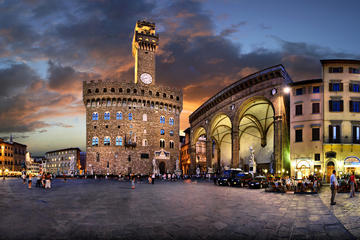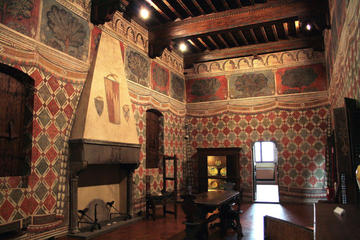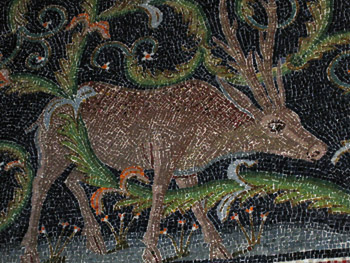 by Sarah Humphreys
by Sarah Humphreys
O lone Ravenna! Many a tale is told
Of thy great glories in the days of old:
Two thousand years have passed since thou didst see
Caesar ride forth to royal victory.
Mighty thy name when Rome’s lean eagles flew
From Britain’s isles to far Euphrates blue;
And of the peoples thou wast noble queen,
Till in the streets the Goth and Hun were seen.”
So Oscar Wilde summarized the history of Ravenna in his poem bearing the city’s name. Ravenna was capital of the Western Roman Empire, The Arian Ostrogothic Kingdom and The Byzantine Empire before becoming kingdom of The Lombards. The final resting place of Dante, was also home to Byron from 1819 to 1821, while he was involved with Teresa Guiccioli, a young married aristocrat. The crowning jewels of Ravenna can be found in her impressive collection of mosaics, which are housed in seven of her eight UNESCO World Heritage Sites. Ravenna is truly the “City of Mosaics” and many of the streets are decorated with modern mosaic designs ranging from flowers to space invaders.
No trip to Ravenna would be complete without visiting her stunning UNESCO sites, described as having “remarkable significance by virtue of the supreme artistry of the mosaic art that the monuments contain, and also because of the crucial evidence that they provide of artistic and religious relationships and contracts at an important part of European History.”
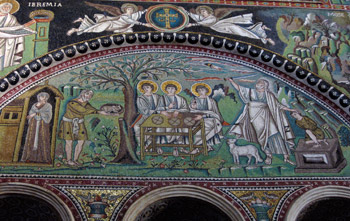 An unknown architect finished the Basilica of San Vitale in 547 on the spot where St Vitalis was martyred by being buried alive. Richly ornamented mosaics inside depict scenes from The Old Testament, including the Sacrifice of Isaac, Moses and The burning bush and Cain and Abel. Decorative leaves, fruit and flowers encircle the Lamb of God on the vault of the presbytery. Glittering mosaics pay homage to the Emperor Justinian I and his Empress Theodora.
An unknown architect finished the Basilica of San Vitale in 547 on the spot where St Vitalis was martyred by being buried alive. Richly ornamented mosaics inside depict scenes from The Old Testament, including the Sacrifice of Isaac, Moses and The burning bush and Cain and Abel. Decorative leaves, fruit and flowers encircle the Lamb of God on the vault of the presbytery. Glittering mosaics pay homage to the Emperor Justinian I and his Empress Theodora.
After straining your neck to look at the beautiful scenes on the ceiling, don’t forget to look at the floor which features simple mosaics of birds and animals, and a marble labyrinth just west of the sanctuary, which consists of 11 concentric circles and leads to a decorative scallop shell.
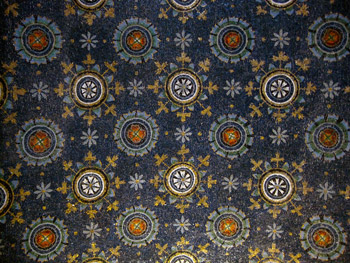 Exiting from the back of San Vitale, you will come across a small, ordinary-looking brick building, which contains Ravenna’s finest treasures. The powerful Roman Empress Galla Placidia, who wielded extreme power as regent for her young son Valentinian III, probably commissioned the tiny Mausoleum which bears her name. Shaped like a Greek cross, the building has sunk 4.5 feet into the ground due to subsidence. The limited space within the structure means visits are restricted to five minutes only, guaranteed to be intense moments.
Exiting from the back of San Vitale, you will come across a small, ordinary-looking brick building, which contains Ravenna’s finest treasures. The powerful Roman Empress Galla Placidia, who wielded extreme power as regent for her young son Valentinian III, probably commissioned the tiny Mausoleum which bears her name. Shaped like a Greek cross, the building has sunk 4.5 feet into the ground due to subsidence. The limited space within the structure means visits are restricted to five minutes only, guaranteed to be intense moments.
The entire vault is covered in ancient mosaic work dating from 430. More than 800 stars are arranged around a golden cross in a deep blue sky, which is said to have so impressed Cole Porter on his visit during his honeymoon that it inspired him to write “Night and Day.” An early depiction of Christ as The Good Shepherd shows him wearing purple robes and a golden tunic. The arches are covered in geometric patterns, which appear almost contemporary with their vivid colouring. The mausoleum contains three sarcophagi, which are attributed to Galla Placida, and the Emperors Valentinian III and Constantinus III. The largest probably contained falsified relics of Galla Placidia, supposedly in sitting position. The relics were destroyed when local boys accidently set fire to them in 1577.
 The Basilica of San Apollinare Nuovo houses a series of impressive mosaics dating from 500 under rule of the Arian King Theodoric, which show scenes of Christ’s miracles, parables and The Passion. The lower rows of mosaics date from 560, when Ravenna was under Christian rule, and feature saints, martyrs and a procession of Virgins led by The Three Magi, sporting animal-print leggings. According to legend, Pope Gregory had the earlier mosaics blackened to prevent worshippers from being distracted, and many of the original Arian mosaics were removed. It is still possible to see some disembodied limbs that evaded destruction.
The Basilica of San Apollinare Nuovo houses a series of impressive mosaics dating from 500 under rule of the Arian King Theodoric, which show scenes of Christ’s miracles, parables and The Passion. The lower rows of mosaics date from 560, when Ravenna was under Christian rule, and feature saints, martyrs and a procession of Virgins led by The Three Magi, sporting animal-print leggings. According to legend, Pope Gregory had the earlier mosaics blackened to prevent worshippers from being distracted, and many of the original Arian mosaics were removed. It is still possible to see some disembodied limbs that evaded destruction.
A fascinating contrast can be seen between the scenes depicted in the Neonian and Arian baptisteries. Although both ceiling mosaics depict the Baptism of Christ by John the Baptist, there are distinct differences between the representations of Christ. The Arian figures are far simpler and Christ is a youthful, beardless figure.
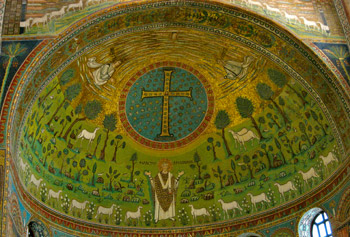 The Chapel of St Andrew, housed in the Archbishop’s museum, is the smallest private early Christian oratory to have survived until the present day. Dazzling mosaics create a shimmering tapestry of saints, angels and decorative motifs and 99 species of birds are shown against a splendid starry sky. Christ is shown as a warrior, crushing the figures of a serpent and a wild beast.
The Chapel of St Andrew, housed in the Archbishop’s museum, is the smallest private early Christian oratory to have survived until the present day. Dazzling mosaics create a shimmering tapestry of saints, angels and decorative motifs and 99 species of birds are shown against a splendid starry sky. Christ is shown as a warrior, crushing the figures of a serpent and a wild beast.
The Basilica of Sant Apollinare in Classe is situated 8km south of Ravenna and contains some of the most impressive artworks in the area. A soft green background, covering the apse, serves as backdrop to various Biblical scenes, representations of the apostles and evangelists and the figure of St Apollinare. This is the first known example of a figure other than Christ being central for the apse decoration. The majestic church also contains Early Christian sarcophagi designed for most of Ravenna’s bishops from the 5th to the 8th centuries.
 The only UNESCO World Heritage Site not to contain mosaics is the Mausoleum of Theodoric. Its unusual structure, consisting of two decagonal parts topped by a monolithic dome, is formed from Istrian stone blocks. The combination of Roman, Barbarian and Medieval architecture fascinated The Romantics and The Mausoleum was popular with tourists on The Grand Tour.
The only UNESCO World Heritage Site not to contain mosaics is the Mausoleum of Theodoric. Its unusual structure, consisting of two decagonal parts topped by a monolithic dome, is formed from Istrian stone blocks. The combination of Roman, Barbarian and Medieval architecture fascinated The Romantics and The Mausoleum was popular with tourists on The Grand Tour.
The proud tradition of mosaic making is kept alive today, using ancient Roman and Byzantine techniques, and it is well worth visiting one of the workshops were you can watch artisans at work. A wide range of souvenirs are available ranging from jewellery boxes and ornaments to re-creations of classical works and sparkling homages to rock stars such as Jimi Hendrix and The Rolling Stones.
 Other notable sites include the extraordinary underwater crypt in the cathedral of San Francesco, complete with goldfish, and the “House of Stone Carpet”, the remains of a Byzantine house complete with huge decorative floor mosaics. Just next to the Cathedral is the final resting place of Dante, who died in Ravenna in 1321. Although exiled form Florence in his lifetime, the city has continuously appealed for the great poet’s remains to be returned. Ravenna has constantly turned down this request. On the 2nd Sunday in September, olive oil donated by the city of Florence, is brought to Ravenna to light the lamb that hangs over Dante’s tomb.
Other notable sites include the extraordinary underwater crypt in the cathedral of San Francesco, complete with goldfish, and the “House of Stone Carpet”, the remains of a Byzantine house complete with huge decorative floor mosaics. Just next to the Cathedral is the final resting place of Dante, who died in Ravenna in 1321. Although exiled form Florence in his lifetime, the city has continuously appealed for the great poet’s remains to be returned. Ravenna has constantly turned down this request. On the 2nd Sunday in September, olive oil donated by the city of Florence, is brought to Ravenna to light the lamb that hangs over Dante’s tomb.
Piazza del Popolo is the real centre of Ravenna, and the perfect place to sit at a pavement café, sip a glass of wine, savour a piadina (stuffed flatbread) and watch the world go by. Every June and July the square is transformed into the backdrop for concerts in the Ravenna Festival, which features classical music, opera, jazz, dance and exhibitions.
Although the main sites in Ravenna could be seen in a day, it is well worth spending longer in this peaceful city. The place where Dante finished his “Divine Comedy” and Byron started writing “Don Juan”, was recently voted the number one place to live by “Il Sole 24 “ financial newspaper and it surely won’t take you long to see why.
If You Go:
♦ The nearest airport is Forli, which is 20km away and is served by Ryanair. Bologna airport is 80km away.
♦ Ravenna is on the main rail line to Bologna and Rimini.
♦ By car take highway A14 – Follow signs for the A14D from A14 East.
♦ The Basilica of San Vitale, Mausoleum of Galla Placidia, Basilica of Sant’ Apollinare Nuovo, Neonian Baptistery and Chapel of St Andrew can only be visited by buying a combined ticket form the ticket office in the centre of town. The Ticket costs €9.50-Reductions €8.50. The ticket is valid for seven consecutive days from the date of issue.
♦ Entrance to The Mausoleum of Theodoric costs €4, Reductions €2
♦ Tickets for the Basilica of Sant’ Apollinare in Classe cost €5, Reductions €2.50
♦ Entrance to the Arian Baptistery is free
♦ Admission times vary according to the time of year. See www.ravennamosaici.it for details.
♦ Queues for the Basilica of San Vitale and Galla Placidia can be quite long. It is best to head there early in the morning or around lunchtime.
♦ The UNESCO World Heritage Sites are all central apart from The Mausoleum of Theodoric, which is just outside the centre and the Basillica of Sant’ Apollinare in Classe, which can be reached by car or bus.
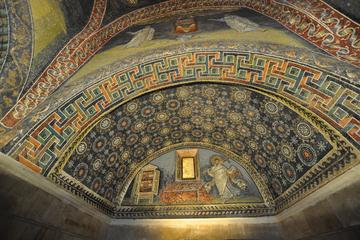
Ravenna and its Enchanting Mosaics Full-day Tour
About the author:
Sarah Humphreys is originally from near Liverpool, UK and has lived in Canada, The USA, The Czech Republic, Greece and Italy. She currently lives in Pistoia, near Florence, where she teaches English, writes freelance and is a part-time poet. She has been writing since she could hold a pencil and her passions include Literature, poetry, music and travel. Follow her on twitter: Sarah Humphreys @frizeytriton.
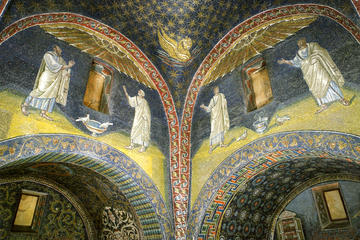
Ravenna and its Mosaics Private Tour with Piadina Tasting
All photos by Sarah Humphreys:
Detail of Mosaic in The Mausoleum of Galla Placidia
The Sacrifice of Isaac-Basilica of San Vitale
Detail of Mosaic in The Mausoleum of Galla Placidia
The Three Magi-Sant’ Apollinare Nuovo
The Apse Sant’ Apollinare in Classe
Traditional Techniques at Work
The Flooded Crypt of San Francesco


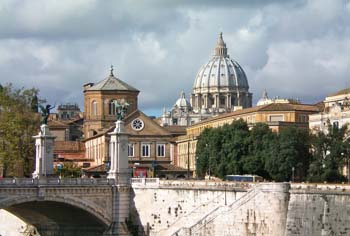
 In 293 BC, Rome suffered from one of the many pestilences which proved the tribulation of the Ancient world. Seeking divine aid, a delegation of high priests and doctors made a pilgrimage to Aesculapius’ temple at Epidaurus. In response to their prayers and offerings, one of the temple’s sacred The success of the quest was thus assured. Upon the ship’s return to Rome, the snake slithered into the Tiber and crossed to the reed-covered island, which lay opposite the city’s port. This was so obvious a sign Aesculapius desired a temple here, not only was one built but the island itself hewn to resemble a ship. Large structures of white travertine were built at either end to augment the resemblance to prow and stern, complete with a bust of Aesculapius and his caduceus. In the centre of the island an obelisk was raised to suggest the main mast of a Roman galley. Thus dedicated to the powerful god of healing, the Isola Tiberina has been associated with the care of the sick ever since.
In 293 BC, Rome suffered from one of the many pestilences which proved the tribulation of the Ancient world. Seeking divine aid, a delegation of high priests and doctors made a pilgrimage to Aesculapius’ temple at Epidaurus. In response to their prayers and offerings, one of the temple’s sacred The success of the quest was thus assured. Upon the ship’s return to Rome, the snake slithered into the Tiber and crossed to the reed-covered island, which lay opposite the city’s port. This was so obvious a sign Aesculapius desired a temple here, not only was one built but the island itself hewn to resemble a ship. Large structures of white travertine were built at either end to augment the resemblance to prow and stern, complete with a bust of Aesculapius and his caduceus. In the centre of the island an obelisk was raised to suggest the main mast of a Roman galley. Thus dedicated to the powerful god of healing, the Isola Tiberina has been associated with the care of the sick ever since. With the growth of Rome, the reputation of the Isola Tiberina’s temple and its doctors grew such that the sick ventured here from all over the Empire to seek healing. Like its namesake at Epidaurus, the temple became famous for the drinking of its miraculous waters, and for dream cures. Most probably opium (or a similar opiate) was used to produce a drugged state filled with dreams, hallucinations, and a susceptibility to suggestion. Hypnosis was a key factor; priests appeared in the dim, smoky light dressed as Aesculapius, and sacred snakes and dogs flickered their tongues over ailing body parts. The fame of these cures was to outlast both the Roman and Greek Empires.
With the growth of Rome, the reputation of the Isola Tiberina’s temple and its doctors grew such that the sick ventured here from all over the Empire to seek healing. Like its namesake at Epidaurus, the temple became famous for the drinking of its miraculous waters, and for dream cures. Most probably opium (or a similar opiate) was used to produce a drugged state filled with dreams, hallucinations, and a susceptibility to suggestion. Hypnosis was a key factor; priests appeared in the dim, smoky light dressed as Aesculapius, and sacred snakes and dogs flickered their tongues over ailing body parts. The fame of these cures was to outlast both the Roman and Greek Empires.
 The hospital can be reached from the Left Bank via the Ponte Fabricio, which links the Old Ghetto to the island. At the junction of the two join stands the Pierloni-Caetani Tower. Built by the Pierloni family before 1000 AD at one of the most strategic approaches along the Tiber to Medieval Rome, it was used first by the Pierlonis and then the Caetanis for control of the river. Jewish in origin, the Caetani family was to produce a pope, Anacletus II. The Adjacent Pierloni-Caetani Castle, which fronts onto the Piazza San Bartolomeo, served as a fortress for several fugitive popes in the Middle Ages. It became a Franciscan monastery in the 17th century, and is now the Tiber Island History museum.
The hospital can be reached from the Left Bank via the Ponte Fabricio, which links the Old Ghetto to the island. At the junction of the two join stands the Pierloni-Caetani Tower. Built by the Pierloni family before 1000 AD at one of the most strategic approaches along the Tiber to Medieval Rome, it was used first by the Pierlonis and then the Caetanis for control of the river. Jewish in origin, the Caetani family was to produce a pope, Anacletus II. The Adjacent Pierloni-Caetani Castle, which fronts onto the Piazza San Bartolomeo, served as a fortress for several fugitive popes in the Middle Ages. It became a Franciscan monastery in the 17th century, and is now the Tiber Island History museum.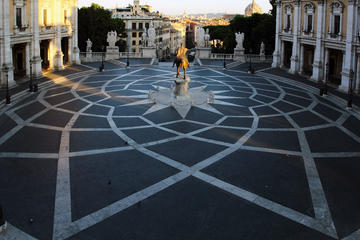

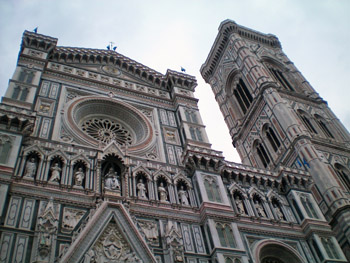
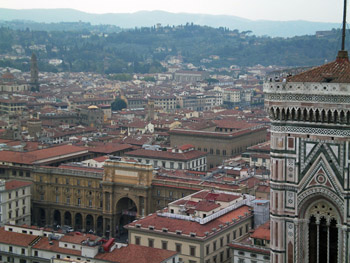 Recognizable to any medieval citizen, the Baptistery and Duomo remain the heart of Florence. Dante’s ‘bel San Giovanni’ is one of the city’s oldest and most famous buildings. Medieval houses still line the Piazza Duomo, many still proudly displaying a stone coat of arms. Like many Florentines of the time, Dante was baptized in the large octagonal font of the Basilica. The building itself dates back to the 4th century. The 13th century mosaics covering the ceiling show with graphic detail the horrors and glories of the Last Judgment. Dante never saw Ghiberti’s famed doors, for they would not grace the building for another century.
Recognizable to any medieval citizen, the Baptistery and Duomo remain the heart of Florence. Dante’s ‘bel San Giovanni’ is one of the city’s oldest and most famous buildings. Medieval houses still line the Piazza Duomo, many still proudly displaying a stone coat of arms. Like many Florentines of the time, Dante was baptized in the large octagonal font of the Basilica. The building itself dates back to the 4th century. The 13th century mosaics covering the ceiling show with graphic detail the horrors and glories of the Last Judgment. Dante never saw Ghiberti’s famed doors, for they would not grace the building for another century.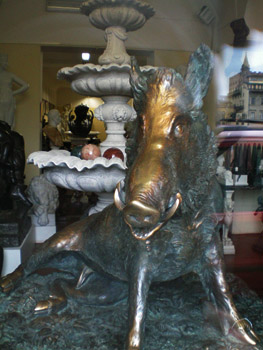 For the hardy, 463 steps lead from the floor of the Duomo and up through a labyrinth of corridors and stairwells to the top of the cupola. (The most difficult part of the climb is over the arch; there is a spot here for lovers to place a padlock and throw away the key. In hidden corners remain marks left on the brickwork by the medieval builders.) The cupola soars to the height of the neighbouring hills. The view embraces the history of Florence, with many a medieval street following the course of their Roman precursors. Private palaces survive, and a few towers – or torre, outlawed in 1250 – still remain.
For the hardy, 463 steps lead from the floor of the Duomo and up through a labyrinth of corridors and stairwells to the top of the cupola. (The most difficult part of the climb is over the arch; there is a spot here for lovers to place a padlock and throw away the key. In hidden corners remain marks left on the brickwork by the medieval builders.) The cupola soars to the height of the neighbouring hills. The view embraces the history of Florence, with many a medieval street following the course of their Roman precursors. Private palaces survive, and a few towers – or torre, outlawed in 1250 – still remain.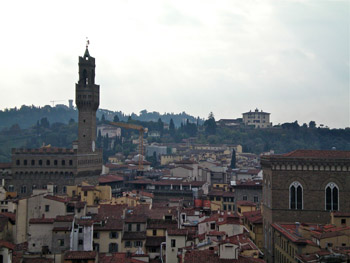 Dominating the Palazzo Vecchio, the Piazza della Signora has continued as the centre of political activity since the Middle Ages. Heavy traffic has been banned since 1385. The imposing façade of the Palazzo Vecchio has remained virtually unchanged since it was built (1299 – 1302) – Dante writes of how the houses of the Ghibelline Uberti were demolished after the triumph of the Guelfs, and the new Palazzo built on their ruins. (The Piazza della Signora is itself built over Roman ruins.)
Dominating the Palazzo Vecchio, the Piazza della Signora has continued as the centre of political activity since the Middle Ages. Heavy traffic has been banned since 1385. The imposing façade of the Palazzo Vecchio has remained virtually unchanged since it was built (1299 – 1302) – Dante writes of how the houses of the Ghibelline Uberti were demolished after the triumph of the Guelfs, and the new Palazzo built on their ruins. (The Piazza della Signora is itself built over Roman ruins.)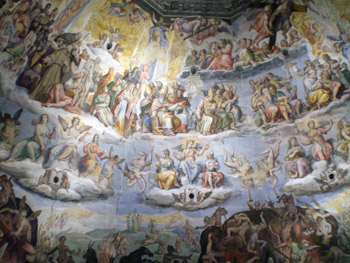 Walking beneath the arch into the Via Santa Margherita leads past the 12th century Santa Margherita de’ Cerchi, where the poet married Gemma Donati (they were betrothed when Dante was nine). It is also where he first saw Beatrice Portinari, the woman he immortalized in his writing. Beatrice’s father, Folco Portinari, is buried here.
Walking beneath the arch into the Via Santa Margherita leads past the 12th century Santa Margherita de’ Cerchi, where the poet married Gemma Donati (they were betrothed when Dante was nine). It is also where he first saw Beatrice Portinari, the woman he immortalized in his writing. Beatrice’s father, Folco Portinari, is buried here.
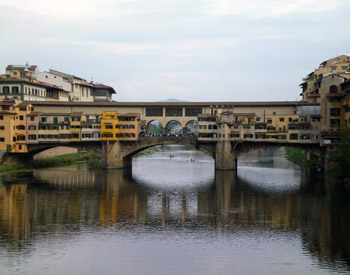 Standing near the site of the original Roman crossing of the Arno, this was the city’s only bridge until 1218. In Dante’s time the Ponte Vecchio was home to butchers and grocers; since the 16th C it had been the place to shop Florence’s most spectacular jewellery.
Standing near the site of the original Roman crossing of the Arno, this was the city’s only bridge until 1218. In Dante’s time the Ponte Vecchio was home to butchers and grocers; since the 16th C it had been the place to shop Florence’s most spectacular jewellery. On the left of the church runs the Costa di San Giorgio; Galileo once lived at No 9. At the end of the road stands the Porta San Giorgio, the oldest of the surviving city gates (Florence was still a wall city in Dante’s time.) A steep walk away is perhaps the most unspoilt of all the Romanesque churches in Tuscany: San Miniato al Monte. It’s classical façade of green-grey and white marble has looked down over Florence since 1018.
On the left of the church runs the Costa di San Giorgio; Galileo once lived at No 9. At the end of the road stands the Porta San Giorgio, the oldest of the surviving city gates (Florence was still a wall city in Dante’s time.) A steep walk away is perhaps the most unspoilt of all the Romanesque churches in Tuscany: San Miniato al Monte. It’s classical façade of green-grey and white marble has looked down over Florence since 1018.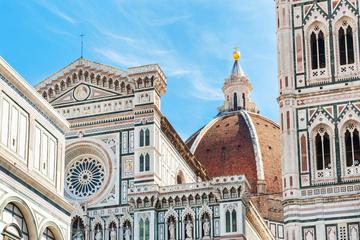
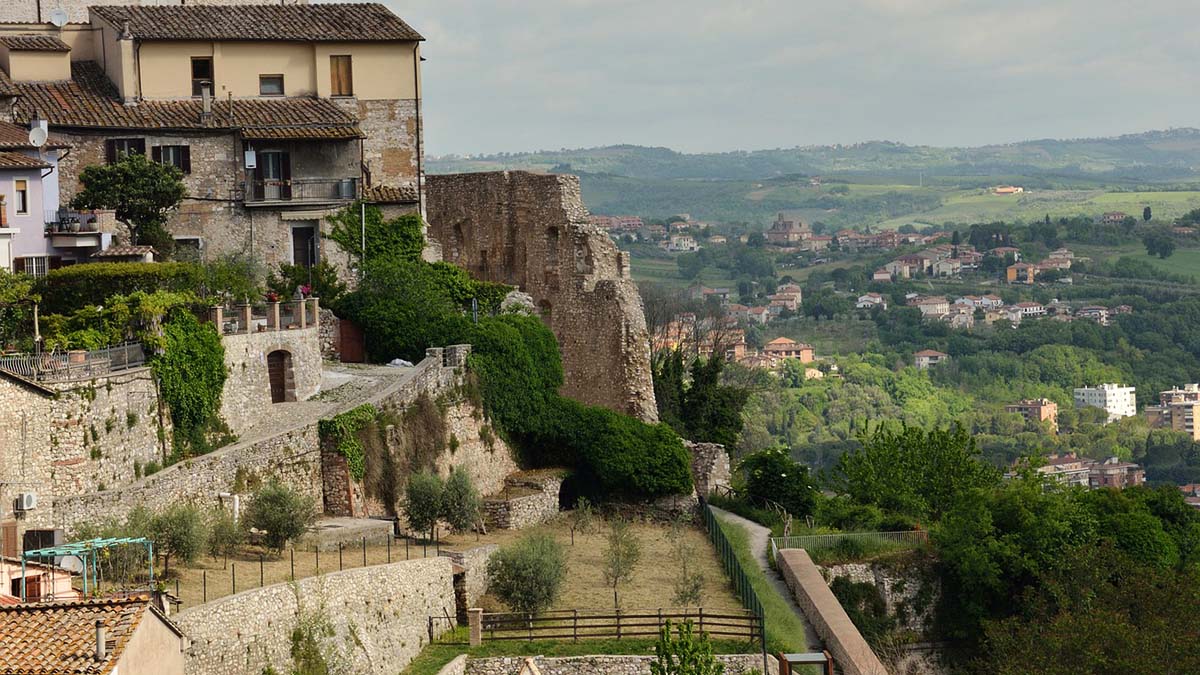
 The delightful medieval town of Narni in Umbria would perhaps have gone almost unnoticed, apart from being considered to be the exact geographical centre of Italy, if it hadn’t been for C.S.Lewis. While examining a Latin atlas of Europe, he came across the name Narnia, which soon took on a whole new meaning. Although Lewis never visited Narnia, or Narni, as it is now known, it may not be pure coincidence that the tomb of Blessed Lucy of Narni can be found in the town’s impressive cathedral. Images of mythical beasts in stone and iron decorate the ancient buildings and streets. The lion features prominently.
The delightful medieval town of Narni in Umbria would perhaps have gone almost unnoticed, apart from being considered to be the exact geographical centre of Italy, if it hadn’t been for C.S.Lewis. While examining a Latin atlas of Europe, he came across the name Narnia, which soon took on a whole new meaning. Although Lewis never visited Narnia, or Narni, as it is now known, it may not be pure coincidence that the tomb of Blessed Lucy of Narni can be found in the town’s impressive cathedral. Images of mythical beasts in stone and iron decorate the ancient buildings and streets. The lion features prominently. Guided tours of Narni Underground nowadays begin in the church, which was consecrated as “Santa Maria delle Rupe”, although the discovery of a copy of a fourteenth century contract revealed the church’s original name as being Chiesa di Sant’Angelo or S. Michele Archangelo (St Michael The Archangel). Although the church has sustained considerable damage, due to water infiltration, beautiful frescos of Christ on the Cross and symbols of the evangelists still adorn the walls and the ceiling is painted with stars and a symbol of The Lamb of God. The Archangel Michael features fighting a dragon and weighing souls. Several skeletons were found in tombs in the floor of the church, which has still not been completely excavated.
Guided tours of Narni Underground nowadays begin in the church, which was consecrated as “Santa Maria delle Rupe”, although the discovery of a copy of a fourteenth century contract revealed the church’s original name as being Chiesa di Sant’Angelo or S. Michele Archangelo (St Michael The Archangel). Although the church has sustained considerable damage, due to water infiltration, beautiful frescos of Christ on the Cross and symbols of the evangelists still adorn the walls and the ceiling is painted with stars and a symbol of The Lamb of God. The Archangel Michael features fighting a dragon and weighing souls. Several skeletons were found in tombs in the floor of the church, which has still not been completely excavated. Convinced there was still more to discover, in May 1979, the young potholers, whose efforts to draw attention to their discovery were largely ignored, found a blocked up door in a garden on the other side of the wall. Being denied permission to try and open the door, the friends took advantage of boisterous festivities, during the local medieval celebration the “Corsa all’Anello”, to cover noise while they made a hole in the door. They were stunned by what they discovered. A short passage led to a large windowless chamber, which later came to light had been used by The Court of the Inquisition to “extract” confessions from those accused of polygamy, blasphemy, witchcraft and adultery- crimes which labelled them as heretics. “The Room of Torment” now contains models of gruesome torture instruments used on these ill-fated souls, including the rack and Judas cradle. Beyond the chamber, the group came across a tiny cell, completely covered in mysterious graffiti. The inscription “Santo Uffizio” (Holy Office), was the key to leading them to understand the area had been used by The Inquisition.
Convinced there was still more to discover, in May 1979, the young potholers, whose efforts to draw attention to their discovery were largely ignored, found a blocked up door in a garden on the other side of the wall. Being denied permission to try and open the door, the friends took advantage of boisterous festivities, during the local medieval celebration the “Corsa all’Anello”, to cover noise while they made a hole in the door. They were stunned by what they discovered. A short passage led to a large windowless chamber, which later came to light had been used by The Court of the Inquisition to “extract” confessions from those accused of polygamy, blasphemy, witchcraft and adultery- crimes which labelled them as heretics. “The Room of Torment” now contains models of gruesome torture instruments used on these ill-fated souls, including the rack and Judas cradle. Beyond the chamber, the group came across a tiny cell, completely covered in mysterious graffiti. The inscription “Santo Uffizio” (Holy Office), was the key to leading them to understand the area had been used by The Inquisition. The graffiti in the prison cell appears to have largely been the work of one desperate prisoner, Giuseppe Andrea Lombardini, whose name is inscribed on the wall under the date 1759 and the remains of the word “Innocent”, which was erased by his guards. Lombardini left a series of cryptic messages and mysterious symbols ,made from a mixture of brick dust and urine, that seem to have a peculiar mixture of origins. Masonic symbols, such as a triangle with a dot, symbolising the eye of the Grand Architect of the Universe merge with strong Christian symbols such as crosses, religious monograms and a representation of the legend of St Nicolas. An image of a tree surrounded by doves is thought to symbolize the tree of life. A sinister falconer catching birds under the tree may represent the church, or the Inquistion itself, destroying freedom. The sequence 7, 24, 42, 70 is repeated in 3 areas within the cell. The sum of the interior numbers is 66, whereas that of the exterior numbers is 77, therefore implying the battle between good and evil. It is interesting to note that the graffiti artist deliberately replaces the letter D with the letter T in his inscriptions, which is believed to express hatred for the Dominican order who ran the Inquisition. Suns, moons, ladders, Jesuit and cabalistic images leave secret messages that have still not been completely deciphered.
The graffiti in the prison cell appears to have largely been the work of one desperate prisoner, Giuseppe Andrea Lombardini, whose name is inscribed on the wall under the date 1759 and the remains of the word “Innocent”, which was erased by his guards. Lombardini left a series of cryptic messages and mysterious symbols ,made from a mixture of brick dust and urine, that seem to have a peculiar mixture of origins. Masonic symbols, such as a triangle with a dot, symbolising the eye of the Grand Architect of the Universe merge with strong Christian symbols such as crosses, religious monograms and a representation of the legend of St Nicolas. An image of a tree surrounded by doves is thought to symbolize the tree of life. A sinister falconer catching birds under the tree may represent the church, or the Inquistion itself, destroying freedom. The sequence 7, 24, 42, 70 is repeated in 3 areas within the cell. The sum of the interior numbers is 66, whereas that of the exterior numbers is 77, therefore implying the battle between good and evil. It is interesting to note that the graffiti artist deliberately replaces the letter D with the letter T in his inscriptions, which is believed to express hatred for the Dominican order who ran the Inquisition. Suns, moons, ladders, Jesuit and cabalistic images leave secret messages that have still not been completely deciphered. In 2004, it was discovered that Trinity College, Dublin housed a number of important documents referring to the Inquisition including transcripts of the trial of Domenico Ciabocchi, confirming the existence of The Inquisition in Narni. Following this discovery, Robert Nini, one of the intrepid potholers and now president of Narni Underground, wrote to Cardinal Ratzinger (later Pope Benedict XIV) who granted him permission to consult the secret archives in the Vatican.
In 2004, it was discovered that Trinity College, Dublin housed a number of important documents referring to the Inquisition including transcripts of the trial of Domenico Ciabocchi, confirming the existence of The Inquisition in Narni. Following this discovery, Robert Nini, one of the intrepid potholers and now president of Narni Underground, wrote to Cardinal Ratzinger (later Pope Benedict XIV) who granted him permission to consult the secret archives in the Vatican.
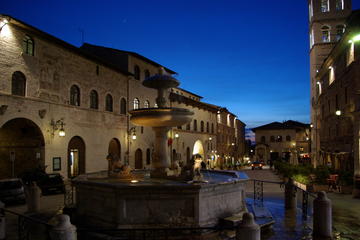

 I am amused and entertained by the wooing of passersby that ensues, the waltz of gestures and pivots, the come-hither looks. Economic casualty aside, I presume the pride of owning an un-Burberry outweighs the pesky oppression of jail. Yesterday, I watched as they installed themselves in front of the Prada store, selling fake Prada bags. Some laugh, some applaud, I cringe.
I am amused and entertained by the wooing of passersby that ensues, the waltz of gestures and pivots, the come-hither looks. Economic casualty aside, I presume the pride of owning an un-Burberry outweighs the pesky oppression of jail. Yesterday, I watched as they installed themselves in front of the Prada store, selling fake Prada bags. Some laugh, some applaud, I cringe. Rashid tells me he came from Marrakesh a couple of years ago. He is 25 and comes every day to the Palazzo Vecchio to surreptitiously sell cheap posters depicting iconic artworks hanging in Italian museums. With knitted brow and eyes cast to the clouds, he proceeds to say that on a good day he’ll sell 10 or 20 at five euros each. He leans in closer and whispers to me, proudly, his biggest seller is Botticelli’s ‘Primavera’.
Rashid tells me he came from Marrakesh a couple of years ago. He is 25 and comes every day to the Palazzo Vecchio to surreptitiously sell cheap posters depicting iconic artworks hanging in Italian museums. With knitted brow and eyes cast to the clouds, he proceeds to say that on a good day he’ll sell 10 or 20 at five euros each. He leans in closer and whispers to me, proudly, his biggest seller is Botticelli’s ‘Primavera’.
 I learn the real David, though housed in a quiet museum, has been attacked a few times, recently by a hammer-wielding fanatic. It was repaired by marble restorers, so is it disqualified from being truly real?
I learn the real David, though housed in a quiet museum, has been attacked a few times, recently by a hammer-wielding fanatic. It was repaired by marble restorers, so is it disqualified from being truly real?